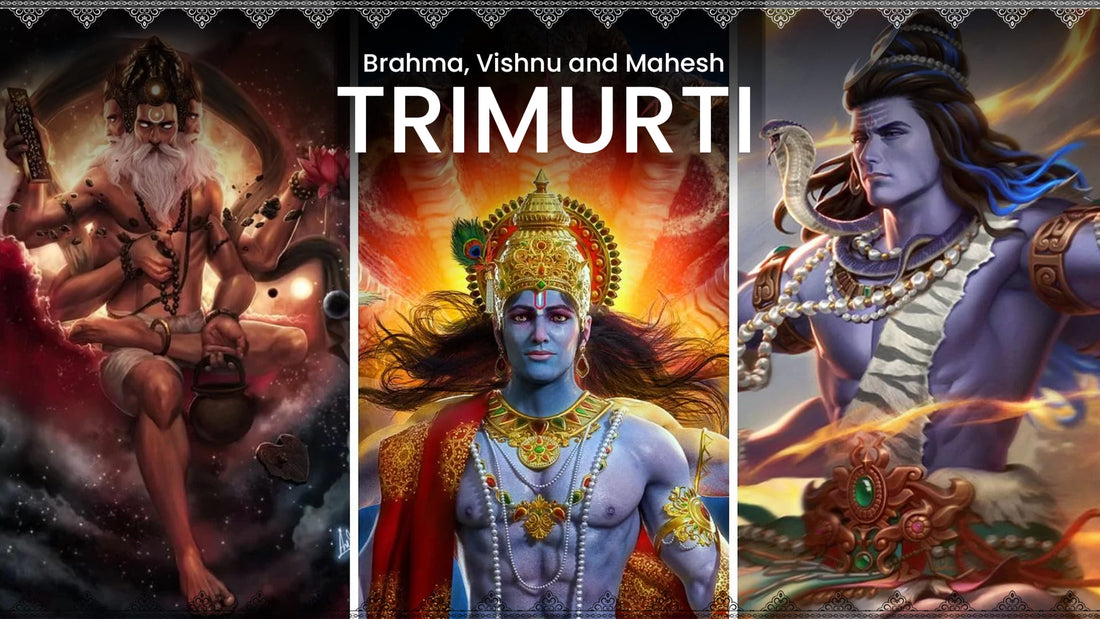In Hinduism, the Trimurti refers to the divine trinity of three major gods: Brahma, Vishnu, and Shiva. This trinity embodies the cosmic functions of creation, preservation, and destruction.
The Trimurti holds immense significance in Hinduism as it represents the cyclical nature of existence and the cosmic balance of the universe. Each deity plays a crucial role in the functioning and maintenance of the cosmos.
Brahma: The Creator
Bhagwan Brahma is regarded as the creator of the universe in Hindu mythology. He is depicted as the progenitor of all living beings and the source of the Vedas, the ancient scriptures of Hinduism. However, his worship is less prevalent compared to Vishnu and Shiva. According to Hindu mythology, Brahma is responsible for creating the universe. He is said to have emerged from a lotus flower from Lord Vishnu's navel. Brahma then created the world and all its inhabitants.
Bhagwan Brahma is typically depicted with four heads, representing the four Vedas, and four arms holding various symbolic objects such as the Vedas, a rosary, a water pot, and a lotus. His vehicle (vahana) is the swan, symbolizing wisdom and discrimination. Brass Shiva statue, brass Shiv murti, Lord Shiva brass statue, Shiva brass idol, and Lord Shiva brass idols are some common representations of Lord Shiva.
Vishnu: The Preserver
Bhagwan Vishnu is revered as the preserver and protector of the universe in Hinduism. He is believed to maintain cosmic order and harmony, intervening whenever the balance is disrupted. Vishnu is said to have incarnated on Earth in various forms known as avatars to uphold righteousness and defeat evil forces. Some well-known avatars include Lord Rama, revered for his ideal qualities and adherence to dharma, and Lord Krishna, known for his teachings in the Bhagavad Gita and his playful yet profound interactions with devotees.

Devotion to Bhagwan Vishnu is widespread among Hindus, who offer prayers and perform rituals to seek his blessings for protection, prosperity, and spiritual upliftment. Vishnu temples are found throughout India and worldwide, where devotees worship his divine presence. Lord Vishnu statue, bhagwan Shri Hari Vishnu, bhagwan Vishnu murti, Vishnu brass idol, brass Vishnu murti, Lord Vishnu brass idol are some common representations of Lord Vishnu.

Mahesh (Shiva): The Destroyer
Lord Shiva, also known as Mahesh or the Great God, is the third member of the Hindu Trimurti. He is revered as the destroyer of ignorance, illusions, and the ego, paving the way for spiritual enlightenment and transformation. Lord Shiva is often depicted with matted hair, a crescent moon adorning his forehead, a trident (trishul) in one hand symbolizing the three aspects of existence (creation, preservation, destruction), and a snake around his neck representing control over desires and ego.
Shiva is central to many Hindu myths and legends, portraying various facets of his character as a benevolent yogi, a compassionate husband to Goddess Parvati, and a fierce destroyer of evil forces. His association with asceticism, meditation, and cosmic dance (Tandava) embodies the eternal cycle of creation and dissolution. Brass Shiva statue, brass Shiv murti, Lord Shiva brass statue, and Lord Shiva brass idols are common representations of Lord Shiva.
Trimurti: Balance and Harmony
The Trimurti embodies the concept of balance and harmony in Hindu cosmology. Each deity—Brahma, Vishnu, and Shiva—represents a fundamental aspect of existence: creation, preservation, and destruction, respectively. Together, they maintain equilibrium in the universe, ensuring the cyclical flow of life and cosmic order.
The interconnectedness of the Trimurti is vividly portrayed in various Hindu scriptures, including the Vedas, Puranas, and epics like the Mahabharata and Ramayana. These texts elucidate the roles and interactions among Brahma, Vishnu, and Shiva, highlighting their complementary functions in sustaining the cosmos.
The Trimurti symbolizes the eternal cycle of creation, preservation, and destruction, known as Srishti, Sthiti, and Samhara in Hindu philosophy. Brahma initiates the process by creating the universe, Vishnu ensures its sustenance and evolution, and Shiva oversees its dissolution to pave the way for regeneration and renewal.
This cyclical nature mirrors the rhythm of life, where birth, growth, and death are integral phases of existence. It emphasizes the transient nature of the material world and the impermanence of all phenomena, leading to spiritual introspection and detachment from worldly attachments.
Worshipping Trimurti
Temples of Lord Shiva and Lord Vishnu are widespread across India and other regions where Hinduism is practiced. These temples serve as worship centers and pilgrimages for devotees seeking spiritual solace and divine blessings. Festivals such as Maha Shivaratri, dedicated to Lord Shiva, and Vaikuntha Ekadashi, honoring Lord Vishnu, are celebrated with great zeal and enthusiasm by millions of devotees worldwide.
Devotees perform various rituals and offer prayers to Lord Vishnu and Lord Shiva as part of their religious practices. These rituals may include daily puja (worship), abhishekam (ritual bathing of the deity), chanting of sacred hymns such as Vishnu Sahasranama and Shiv Tandav Stotram, and offering of flowers, fruits, incense, and other auspicious items as a mark of reverence and devotion.
The worship of Lord Vishnu and Lord Shiva holds profound significance in modern Hindu practices, transcending geographical boundaries and cultural differences. Many devotees turn to these divine deities for guidance, protection, and spiritual fulfillment in their everyday lives. The timeless teachings and legends associated with Vishnu and Shiva inspire individuals to lead virtuous lives and cultivate virtues such as compassion, humility, and selflessness.
Unity in Diversity: Trimurti- Brahma, Vishnu, and Mahesh
The Trimurti, comprising Brahma, Vishnu, and Shiva, represents the cosmic principles of creation, preservation, and destruction, respectively. Together, they form the foundational pillars of Hindu cosmology and philosophy, guiding humanity towards spiritual awakening and enlightenment.
The Trimurti symbolizes the unity in diversity inherent in Hinduism, where multiple deities and traditions coexist harmoniously, reflecting the diverse aspects of the divine. Each member of the Trimurti embodies unique qualities and attributes, yet they are interconnected and interdependent, emphasizing the interconnectedness of all existence.
In an era marked by rapid societal changes and global challenges, the timeless wisdom and symbolism of the Trimurti offer invaluable insights into the nature of reality and the human condition. The profound teachings of Brahma, Vishnu, and Shiva resonate with seekers of truth and wisdom, inspiring them to cultivate spiritual awareness, compassion, and reverence for all forms of life.
Frequently Asked Questions
What does Brahma, Vishnu, Mahesh represent?
Brahma represents creation, Vishnu represents preservation, and Mahesh (Shiva) represents destruction or transformation. Together, they symbolize the cycle of creation, preservation, and destruction in the universe, known as the Trimurti.
Is Trimurti mentioned in Vedas?
The concept of Trimurti, featuring Brahma, Vishnu, and Mahesh are prominently mentioned in various Vedic texts.
Who is the god of the Trimurti?
The Trimurti consists of three primary deities: Brahma, Vishnu, and Mahesh (Shiva). Each deity represents a different aspect of the cosmic functions: creation, preservation, and destruction, respectively.
Is Vishnu in the Trimurti?
Yes, Vishnu is one of the principal deities in the Trimurti. He represents the aspect of preservation, ensuring the continuity and order in the universe. Along with Brahma and Mahesh (Shiva), Vishnu forms the divine trinity known as the Trimurti in Hinduism.


